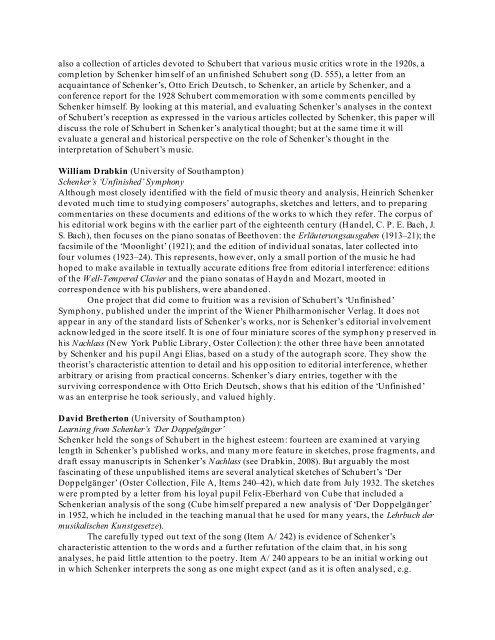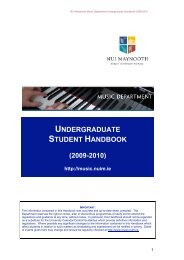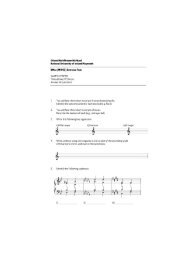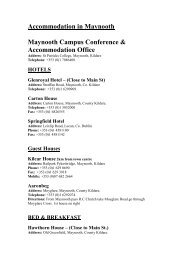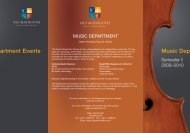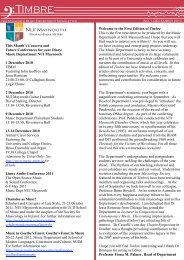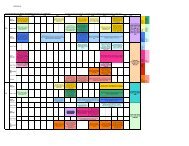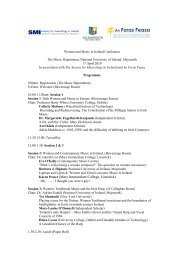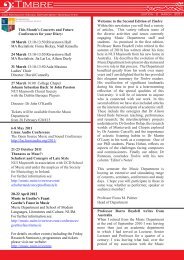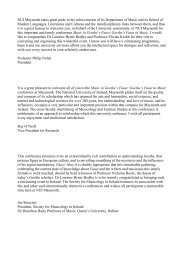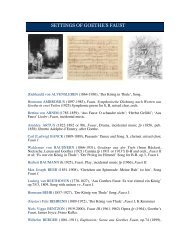Conference Booklet - Music - National University of Ireland, Maynooth
Conference Booklet - Music - National University of Ireland, Maynooth
Conference Booklet - Music - National University of Ireland, Maynooth
You also want an ePaper? Increase the reach of your titles
YUMPU automatically turns print PDFs into web optimized ePapers that Google loves.
also a collection <strong>of</strong> articles devoted to Schubert that various music critics wrote in the 1920s, a<br />
completion by Schenker himself <strong>of</strong> an unfinished Schubert song (D. 555), a letter from an<br />
acquaintance <strong>of</strong> Schenker‘s, Otto Erich Deutsch, to Schenker, an article by Schenker, and a<br />
conference report for the 1928 Schubert commemoration with some comments pencilled by<br />
Schenker himself. By looking at this material, and evaluating Schenker‘s analyses in the context<br />
<strong>of</strong> Schubert‘s reception as expressed in the various articles collected by Schenker, this paper will<br />
discuss the role <strong>of</strong> Schubert in Schenker‘s analytical thought; but at the same time it will<br />
evaluate a general and historical perspective on the role <strong>of</strong> Schenker‘s thought in the<br />
interpretation <strong>of</strong> Schubert‘s music.<br />
William Drabkin (<strong>University</strong> <strong>of</strong> Southampton)<br />
Schenker’s ‘Unfinished’ Symphony<br />
Although most closely identified with the field <strong>of</strong> music theory and analysis, Heinrich Schenker<br />
devoted much time to studying composers‘ autographs, sketches and letters, and to preparing<br />
commentaries on these documents and editions <strong>of</strong> the works to which they refer. The corpus <strong>of</strong><br />
his editorial work begins with the earlier part <strong>of</strong> the eighteenth century (Handel, C. P. E. Bach, J.<br />
S. Bach), then focuses on the piano sonatas <strong>of</strong> Beethoven: the Erläuterungsausgaben (1913–21); the<br />
facsimile <strong>of</strong> the ‗Moonlight‘ (1921); and the edition <strong>of</strong> individual sonatas, later collected into<br />
four volumes (1923–24). This represents, however, only a small portion <strong>of</strong> the music he had<br />
hoped to make available in textually accurate editions free from editoria l interference: editions<br />
<strong>of</strong> the Well-Tempered Clavier and the piano sonatas <strong>of</strong> Haydn and Mozart, mooted in<br />
correspondence with his publishers, were abandoned.<br />
One project that did come to fruition was a revision <strong>of</strong> Schubert‘s ‗Unfinished‘<br />
Symphony, published under the imprint <strong>of</strong> the Wiener Philharmonischer Verlag. It does not<br />
appear in any <strong>of</strong> the standard lists <strong>of</strong> Schenker‘s works, nor is Schenker‘s editorial involvement<br />
acknowledged in the score itself. It is one <strong>of</strong> four miniature scores <strong>of</strong> the symphony p reserved in<br />
his Nachlass (New York Public Library, Oster Collection): the other three have been annotated<br />
by Schenker and his pupil Angi Elias, based on a study <strong>of</strong> the autograph score. They show the<br />
theorist‘s characteristic attention to detail and his opp osition to editorial interference, whether<br />
arbitrary or arising from practical concerns. Schenker‘s diary entries, together with the<br />
surviving correspondence with Otto Erich Deutsch, shows that his edition <strong>of</strong> the ‗Unfinished‘<br />
was an enterprise he took seriously, and valued highly.<br />
David Bretherton (<strong>University</strong> <strong>of</strong> Southampton)<br />
Learning from Schenker’s ‘Der Doppelgänger’<br />
Schenker held the songs <strong>of</strong> Schubert in the highest esteem: fourteen are examined at varying<br />
length in Schenker‘s published works, and many m ore feature in sketches, prose fragments, and<br />
draft essay manuscripts in Schenker‘s Nachlass (see Drabkin, 2008). But arguably the most<br />
fascinating <strong>of</strong> these unpublished items are several analytical sketches <strong>of</strong> Schubert‘s ‗Der<br />
Doppelgänger‘ (Oster Collection, File A, Items 240–42), which date from July 1932. The sketches<br />
were prompted by a letter from his loyal pupil Felix-Eberhard von Cube that included a<br />
Schenkerian analysis <strong>of</strong> the song (Cube himself prepared a new analysis <strong>of</strong> ‗Der Doppelgänger‘<br />
in 1952, which he included in the teaching manual that he used for many years, the Lehrbuch der<br />
musikalischen Kunstgesetze).<br />
The carefully typed out text <strong>of</strong> the song (Item A/ 242) is evidence <strong>of</strong> Schenker‘s<br />
characteristic attention to the words and a further refutation <strong>of</strong> the claim that, in his song<br />
analyses, he paid little attention to the poetry. Item A/ 240 appears to be an initial working out<br />
in which Schenker interprets the song as one might expect (and as it is <strong>of</strong>ten analysed, e.g.


